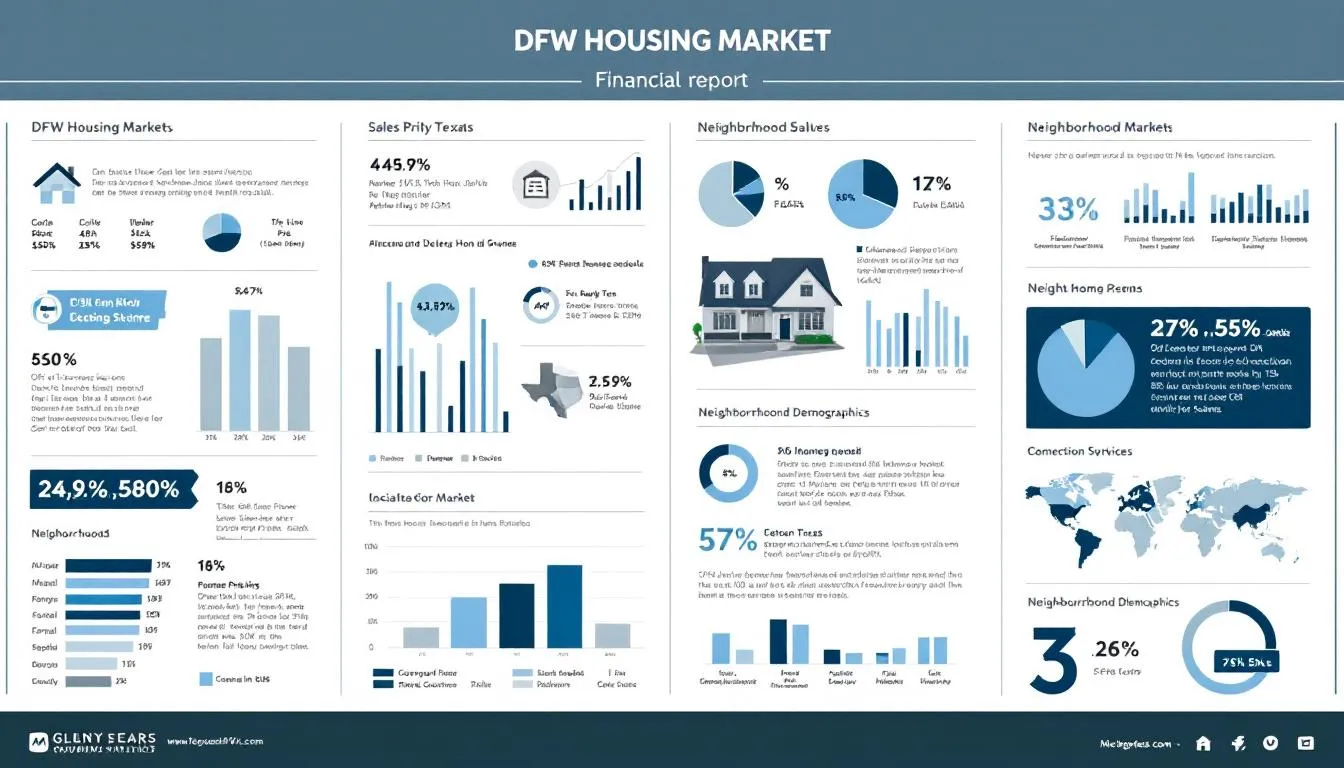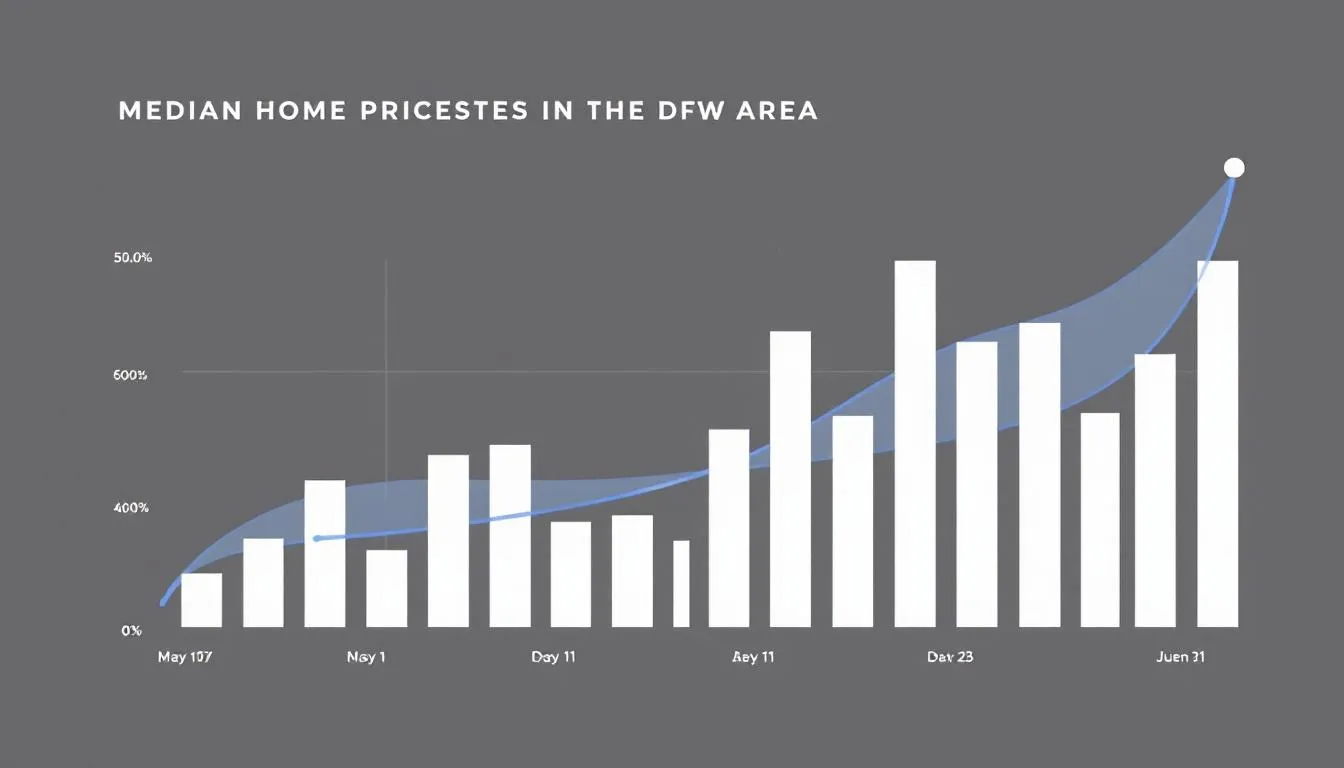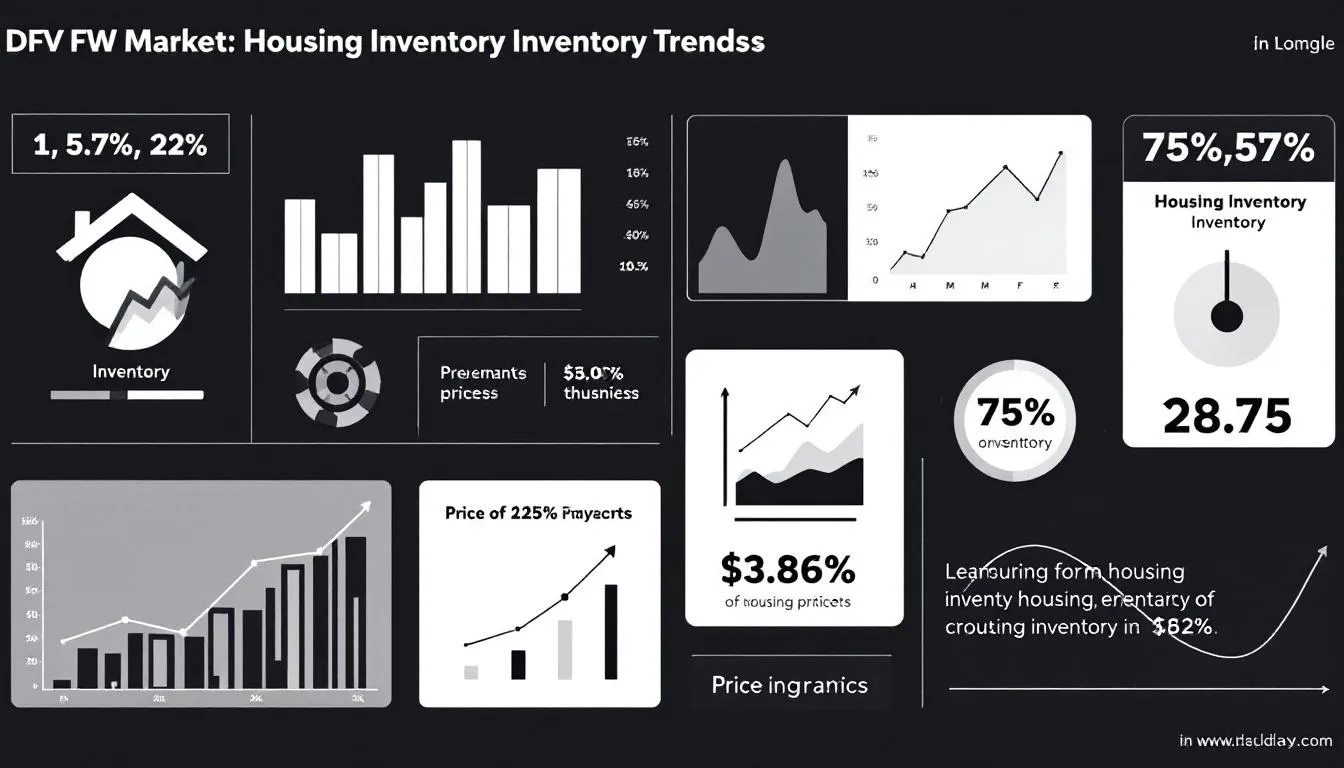The DFW housing market in 2025 is marked by fluctuating prices and growing inventory. This article covers the key trends, market conditions, and strategic insights for buyers and sellers in this dynamic environment.

The DFW housing market is currently in a state of transition. Various influences are affecting pricing and sales, creating a dynamic environment for both buyers and sellers. The median home price of $399,130 reflects the broader economic fluctuations. The median price per square foot stands at $193.53, offering a snapshot of the cost dynamics in the region.
Home sales in the DFW area have seen a slight decline, with a 2.03% decrease year-to-date. In May 2025 alone, there were 9,195 home sales, indicating a robust yet slightly cooling market. A surge in housing inventory is shifting the market towards a buyer’s situation, leading to a decline in sales.
Growing inventory is expected to lead to price drops in the DFW housing market. The average home value in the Dallas-Fort Worth-Arlington area is around $377,186, highlighting the affordability aspect compared to other major metropolitan areas. This surge in inventory and the resulting price adjustments are pivotal factors shaping the market today.

Home prices in the DFW area have been experiencing notable changes:
Potential buyers and sellers must consider this decline.
Specific counties within the DFW metroplex exhibit varied trends:
The average price of homes sold in Dallas dropped by 1.75% compared to the previous year, settling at $516,731. This trend underscores the broader market dynamics, where increased housing inventory and economic factors have led to adjustments in home prices. This evolving market presents opportunities for buyers, while sellers need to adapt their strategies to remain competitive.

The DFW area is currently regarded as the fourth most oversupplied housing market in the U.S. A significant increase in new listings, surging to 123,000 by April 2025 (a 53% increase), has led to this oversupply in housing supply. The inventory of active listings in the Dallas market has also increased by 37.20%, reaching 35,555 homes.
Housing inventory surged, leading to a 12% year-over-year increase in the DFW housing market. Months of supply in various counties have risen significantly, with Dallas County seeing a 41% rise to 4.5 months, and Collin County reaching 4.3 months, an increase of 48%. Overall, the months of supply for homes in DFW is currently 4.85 months, reflecting a more balanced market.
Significant inventory growth is evident in regions like Denton County, with a 63% increase, and Kaufman County, with a 31% rise in homes for sale. The inventory of townhomes and condominiums has also increased significantly, leading to a more competitive environment for buyers. These trends indicate a more balanced DFW housing market, offering increased opportunities for buyers and requiring strategic considerations for sellers.

Buyer demand in the DFW housing market is undergoing significant changes:
Many buyers now expect either homes in perfect condition or competitive pricing, leading them to request significant concessions. The flexibility to take their time evaluating properties and making a comparison of decisions without the pressure of immediate offers is a notable change from the past few years, as data shows a shift in buyer behavior since last year, with many houses being listed for sale in real estate.
Homes lingering on the market longer often present better negotiation opportunities for buyers. Overall, buyer activity has increased as buyers take advantage of improved market conditions in DFW.
Mortgage rates have a significant impact on the DFW housing market. As of July 10, 2025, the average mortgage rate for a 30-year fixed loan is approximately 6.72%. These higher mortgage rates are a significant factor in making homes less affordable for buyers, influencing their purchasing decisions. Despite these high rates, there are signs of increased home purchase and refinance applications as mortgage rates begin to decline.
However, experts predict that high mortgage rates will not drop significantly in the near future. Buyers and investors need to navigate the current landscape with a clear understanding of how these rates affect affordability and overall market dynamics. Higher interest rates underscore the need for strategic financial planning and leveraging available market opportunities.
In 2025, the market for single-family homes in Dallas has seen notable changes. In May, sales of single-family homes totaled 8,728, representing a slight year-over-year decline of 0.58%. The dollar volume for these sales was approximately $4.54 billion, showing a decrease of 2.74% from the previous year. These figures mirror the broader market trends affecting single-family homes.
Key statistics for single-family homes in Dallas as of May 2025:
The average price per square foot for single-family homes in Dallas was $209.64 in May 2025, reflecting a decrease of 2.41% year over year. Additionally, homes in Dallas took an average of 86 days to sell, which represents an increase of about 14.67% from the previous year. These trends highlight the evolving dynamics in the single-family home segment, offering both challenges and opportunities for buyers and sellers.
The performance of townhomes and condominiums in the DFW market has seen a significant decline. There was a 32.29% decrease in condominium sales year-over-year, indicating weaker demand for this property segment. Similarly, sales of townhomes decreased by 26.65% year-over-year, further highlighting the challenges in this market.
The demand for townhomes and condominiums is weaker, with a notable decline in market performance. These trends indicate that buyers in this segment are more cautious, possibly seeking more affordable or single-family home types options.
Sellers in the townhome and condominium market need to be particularly strategic in their pricing and marketing efforts to attract potential seller buyers.
The rental market in Dallas is characterized by geographic diversity and varying price points. The average rent for apartments has seen a slight decline, currently sitting at approximately $1,419 per month, which is 13% below the national average. Prices for one-bedroom apartments range from $951 in affordable neighborhoods to over $3,400 in premium areas. This diversity provides options for renters with varying budget constraints.
The rental market is projected to see a recovery in rents by late 2025, with an anticipated increase of 1.5% year-over-year across property segments. Vacancy rates across the DFW rental market are around 5%, though they can vary significantly by location and property type.
Suburban areas are becoming increasingly popular for renters, particularly single-family rental homes in the neighborhood, attracting millennials and Gen Z looking for lifestyle amenities. This trend highlights the dynamic nature of the rental market in DFW.
The DFW housing market is experiencing varied trends across different counties, with some areas showing more resilience than others. Unique dynamics in each DFW metroplex county shape the local housing market.
This section delves into the specifics of Collin, Denton, Tarrant, and Texas Dallas country counties, providing a localized perspective on the broader trends.
Collin County has seen a significant increase in housing inventory, with levels rising by over 60%. This surge in inventory has contributed to a decrease in the median sales price, now at $480,000, reflecting a 3.7% decline.
These trends create a more competitive market compared environment, providing buyers with better negotiation opportunities.
Denton County is experiencing a notable rise in housing inventory, with a 63% increase. This significant growth in inventory levels is impacting the market dynamics, signaling a balanced market where buyers have more options and negotiating power.
Increased inventory creates a more favorable environment for buyers.
Tarrant County is witnessing a stable pricing environment despite growing inventory, suggesting balanced market conditions. The inventory levels are increasing, but the prices remain stable, indicating a resilient market that offers opportunities for both buyers and sellers.
Dallas County’s median home price is $385,000, showing a modest growth of 1.3%. Characterized by modest price growth, the market environment remains stable.
Additionally, there is an increase in inventory and longer selling times in Dallas County, reflecting broader market trends and offering opportunities for strategic buyers and sellers.

The future outlook for the DFW housing market indicates a shift towards a more balanced market rather than a seller’s market. The market correction appears to be accelerating. This trend is particularly evident in the starter and mid-tier categories. However, no crash is expected, with experts predicting only a slight decrease in home values over the next year.
Homeowners and investors are advised to focus on long-term value due to ongoing market fluctuations. A gradual correction in home prices is anticipated for 2026, with a moderate cool-down forecasted for Dallas in the coming years. Despite these adjustments, the outlook for the Dallas housing market trends remains positive.
As the DFW housing market shifts towards a buyer’s market, there are several strategies that buyers can employ to navigate this new landscape. With 66% of homes selling for less than the asking price, buyers have more room to negotiate and secure favorable deals. In areas like Rockwall County, where there is nearly six months of inventory and extended days on market, buyers can take their time and make informed decisions.
Offering concessions like repair credits or closing cost assistance can make offers more attractive to sellers in a competitive market. Buyers should set realistic expectations and plan strategically rather than relying on outdated approaches.
Increased inventory and a slower buyer’s market pace give buyers more choices and better negotiation opportunities.
Sellers in the DFW housing market must adapt to the shifting conditions to achieve successful sales. Key strategies include:
Adapting to changing market conditions means being flexible with pricing and negotiation tactics. Sellers who can present their properties well and offer competitive prices will have a better chance of securing deals in the current buyer’s market. Understanding the market dynamics and being proactive in their approach will help sellers navigate these challenges successfully.
In summary, the DFW housing market in 2025 presents a dynamic and evolving landscape with opportunities and challenges for both buyers and sellers. From the significant increase in housing inventory and the shift towards a buyer’s market to the impact of mortgage rates and the varied trends across different counties, understanding these factors is crucial. Buyers can leverage the current market conditions to negotiate favorable deals, while sellers must adapt their strategies to attract potential buyers. Staying informed and adaptable will be key to navigating the DFW housing market successfully.
The current median home price in the Dallas-Fort Worth area is $399,130. This reflects the recent market trends in the region.
The housing inventory in the DFW area has experienced a substantial increase, with listings rising by 37.20% and a remarkable 53% surge in housing listings by April 2025. This trend indicates a growing market with more options for potential buyers.
Mortgage rates have significantly impacted the DFW housing market by decreasing affordability for buyers, yet recent declines in rates are encouraging a rise in home purchase and refinance applications.
To navigate the current DFW housing market effectively, buyers should leverage the increased inventory to negotiate favorable terms, such as repair credits or assistance with closing costs, while maintaining realistic expectations throughout the process.
Sellers in the DFW market must be ready to negotiate, establish realistic pricing, enhance property presentation, and employ strategic marketing to successfully attract buyers. Adapting to these conditions is essential for achieving optimal sales results.